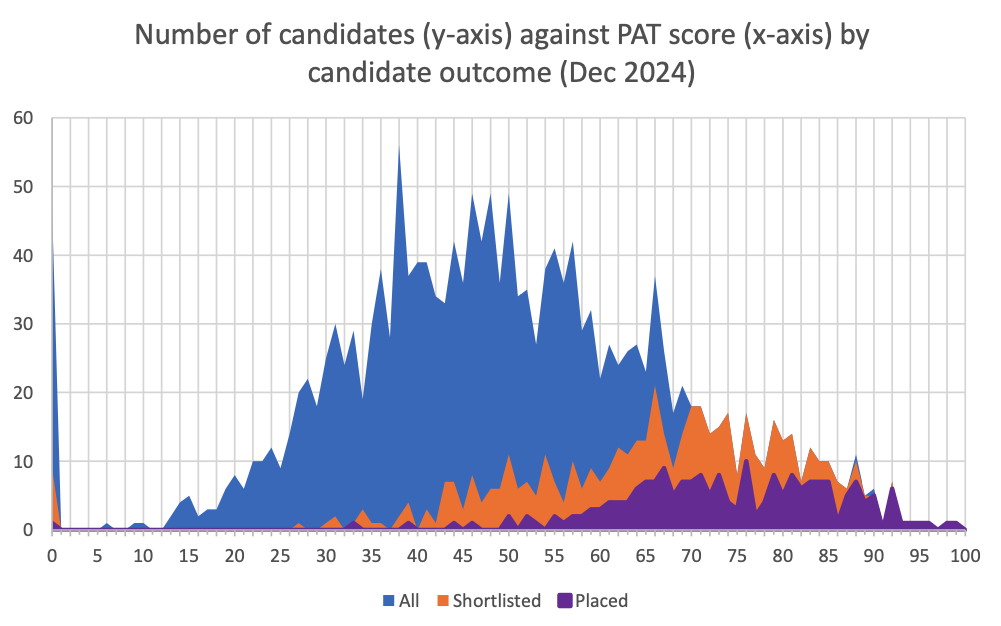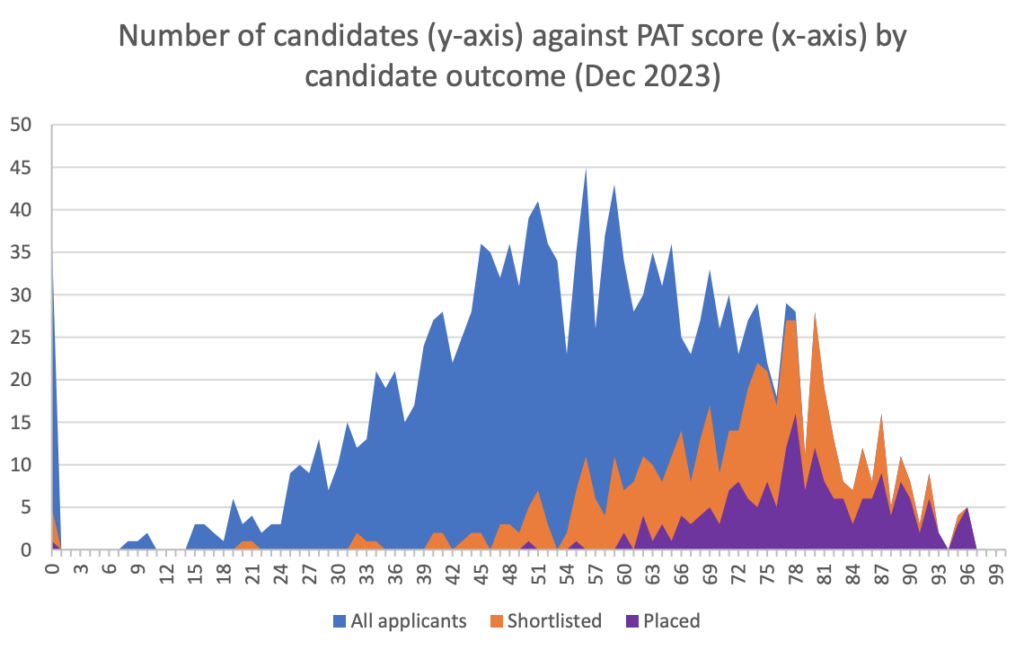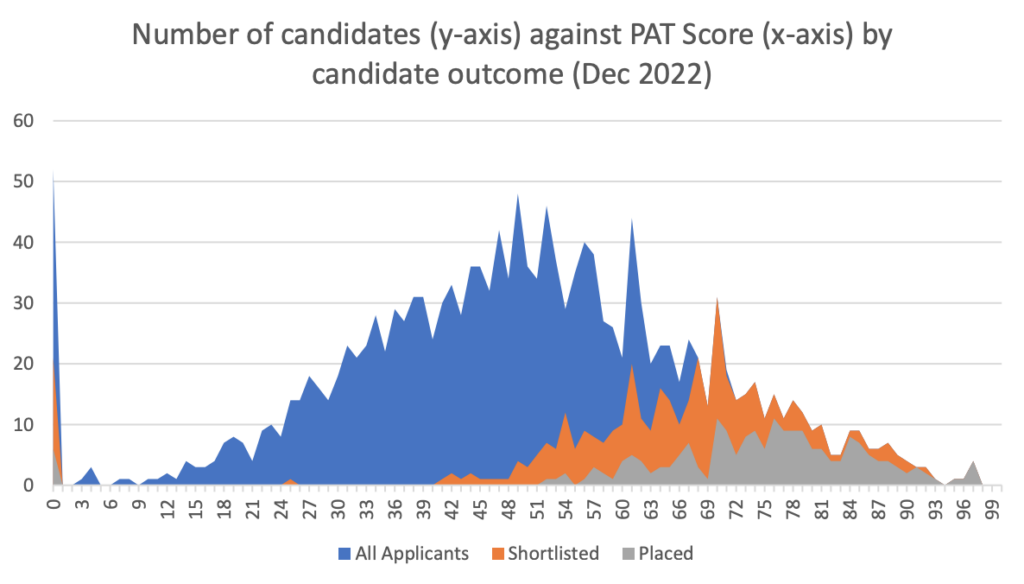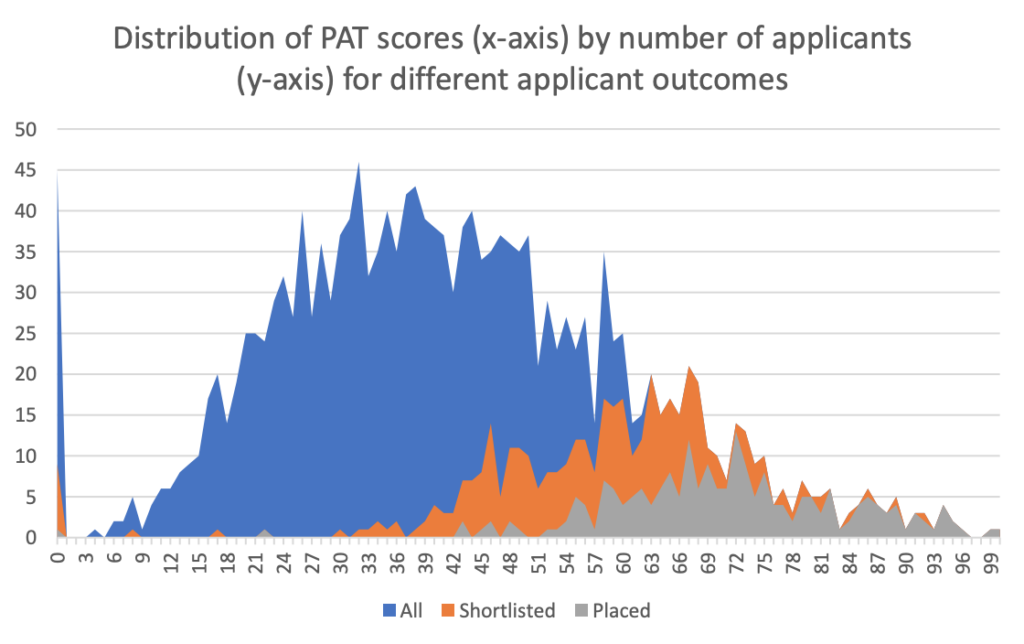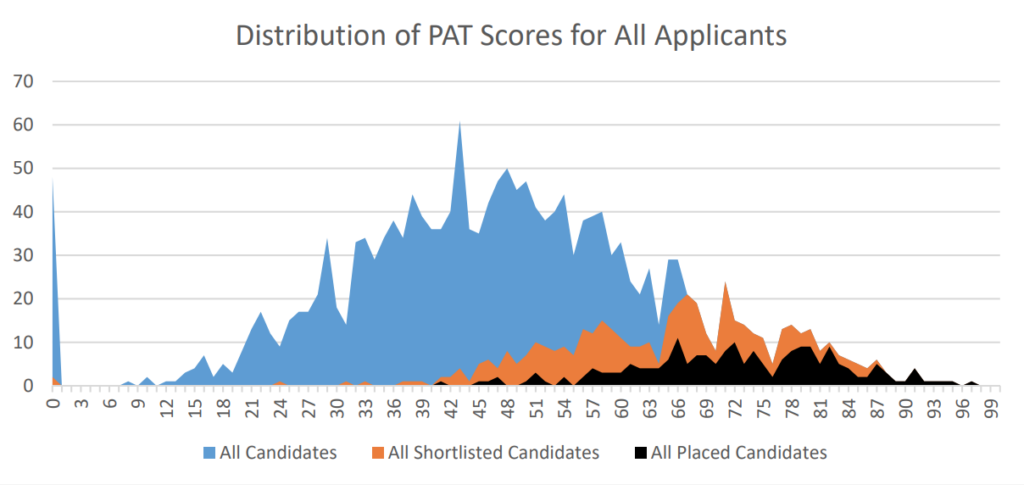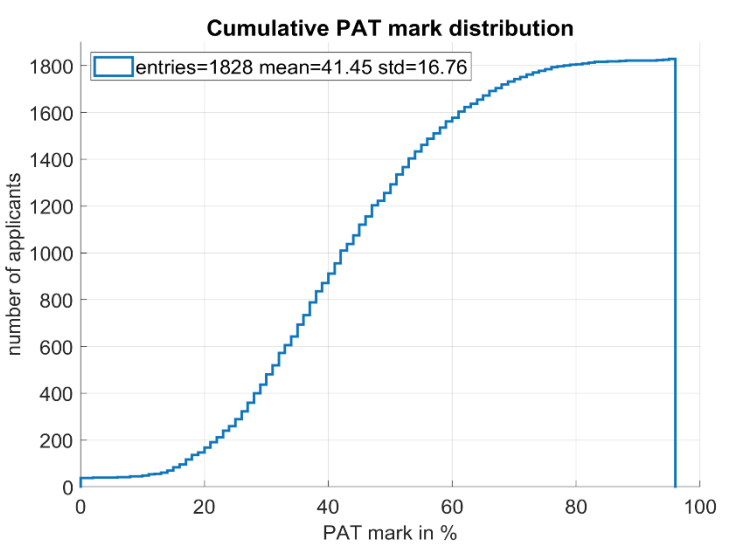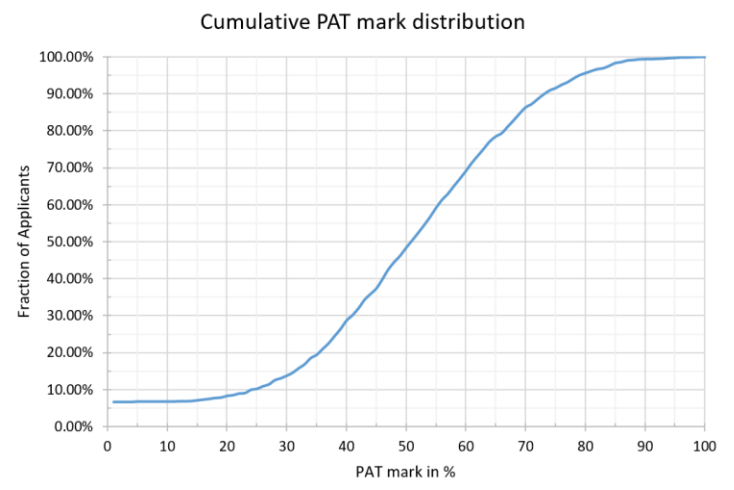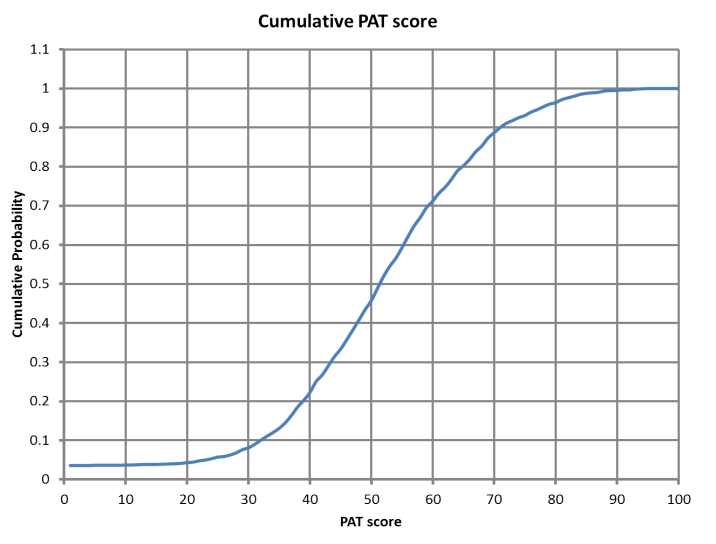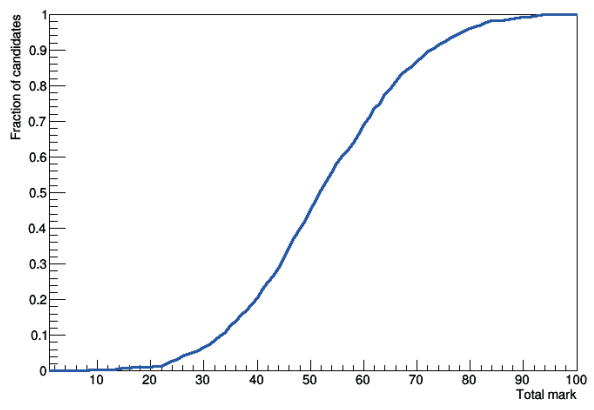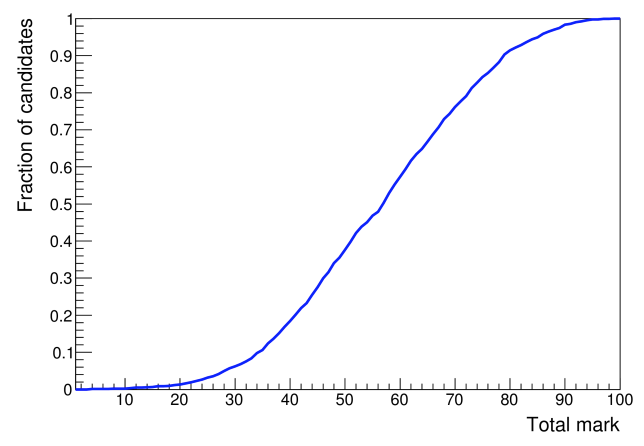YOUR ULTIMATE GUIDE
PAT Oxford Results 2024 - The Definitive Guide to your PAT Score
Written by: Matt Amalfitano-Stroud
Please be aware that the PAT has faced a major format change in 2024 that has removed all written questions from the test. The PAT will now only contain multiple-choice questions, so the scoring system will likely be different. The full scoring system hasn’t been revealed yet, so this guide will be fully updated when this information is available.
Once you’ve sat the Oxford Physics Aptitude Test (PAT), it feels like there’s only one thing that matters; your results. The score you get from this test will be one of the biggest deciding factors in whether you get your offer or not. Even before you’ve sat the test, it’s important to know what result you should be aiming for, so let’s take a look at how Oxford scores the PAT and what your results mean!
1/4
HOW IS THE PAT SCORED?
First things first, let’s discuss the scoring system for the PAT and how your results will be presented.



When compared to other admissions tests of a similar nature (such as the ESAT), we can see that the PAT has one of the simplest marking schemes of any exam. This summary explains everything you need to know.
While the PAT was originally made up of three different question types, the test has since been simplified to become computer-based. The PAT now consists of 40 multiple-choice questions. Each question is worth 2, 3 or 4 marks depending on difficulty, all marks add up to a total of 100 for the entire test.
The conversion between your raw marks out of 100 to your final score is incredibly simple, as your final score will simply be a percentage, identical to the number of marks. There is no negative marking here, so you don’t need to worry about losing marks from incorrect answers.
Other than that, there’s nothing else of note regarding the PAT’s scoring system. Marking is done automatically, although applicants will not receive their results until late January when offers are released. With that, let’s move on to an important question; what is a good PAT score?
Struggling with your PAT preparation?
PAT.Ninja can boost your score quickly with our expert suite of preparation tools. You can try the platform out for free today, all you need to do is sign up!
2/4
WHAT IS A GOOD PAT RESULT?
With the basics out of the way, let’s look at what scores you should be aiming for and what you can do if you don’t meet the mark.



Determining what a good PAT score is actually not as difficult as you may think, as you simply need to answer one question:
Does Oxford Have a PAT Cut-Off Score?
Oxford does not implement a strict cut-off score for the PAT. However, they do implement an upper threshold in which any applicants who score above a certain mark will be automatically shortlisted for interview. Applicants who score below this score will still be considered and will be shortlisted if other aspects of their application show a high level of quality.
This was a score calculated as such:
R-score (pre-shortlist) = PAT mark + 10 x cGCSE
This process was likely changed due to the influx of applicants in the pandemic and the reduced reliance on grades and predicted grades in the application process. These are the cut-off scores for the last three years of the exam:
Oxford PAT Cut-off Score 2025 Entry
70%
Oxford PAT Cut-off Score 2024 Entry
75%
Oxford PAT Cut-off Score 2023 Entry
68%
There is currently no confirmation that this system will continue for the 2024 sitting for 2025 Entry, so this may not be an option for applicants in the future.
However, if you’re consistently scoring in the high 60s – 70s during your prep, then your chances at an interview are very good. But this would be a really good score and scoring lower isn’t going to ruin your chances completely.
Each year a mean score is calculated out of all of the applicants, which gives us another clue as to what a decent PAT score would be. Ideally, you’re going to want to be as far away as possible from the mean score (on the upper end, of course!), but just scoring above average at all is still a good thing.
Be aware that these scores are based on the previous PAT format, which was generally more difficult than the current one as it had more complex written questions rather than just mutliple-choice questions. However, the averages for the last three years were:
Mean Oxford PAT Score 2024 Entry
49.6%
Mean Oxford PAT Score 2023 Entry
55.6%
Mean Oxford PAT Score 2023 Entry
51.2%
Mean Oxford PAT Score 2022 Entry
43.1%
We’ll come back to the Historic Results later on, but here we can see that averages have gradually increased to above 50% indicating that either the test is getting easier or applicants are becoming better prepared for it. Therefore, getting over half marks is going to give you a decent chance of being shortlisted, provided the rest of your application is high-quality.
Oxford has stated that they aim to interview around 2.5 applicants per place, though this was raised to 2.9 in 2023. While high, this still gives good applicants a fair chance, even if they don’t perform the best in the PAT.
What If I Get a Bad PAT Result?
With above average must, of course, come below average. This definitely isn’t a desirable spot to be in and will endanger your application to a significant degree. Oxford is known for its stricter shortlisting process when compared to Cambridge, so be sure to bear this in mind when choosing your course.
With that being said though, no strict cut-off score means that your application will be viewed no matter what score you got. If you’ve got a lower score, your personal statement is going to be the main thing that could save you from failure. This will be submitted before October 15th with the rest of your application, meaning you’re not going to have the chance to sit the PAT beforehand. Therefore, it’s important to ensure you’ve written your statement like your application literally depends on it!
Grades also play a factor here, but they are nowhere near as important as they would have been in the past. Excellent grades are expected of all applicants and are not going to set you apart from the competition, so you can’t rely on them getting you through your application.
Can I Resit the NSAA?
No, the PAT can only be sat once per admissions cycle. Unfortunately, the only option you’ll have if you don’t perform well on the PAT is to reapply for the following year. When preparing for this reapplication, its vital that you work on improving the areas you were weak in last time. If the issue stems from your PAT abilities, it is worth investing in a form of preparation support such as PAT.Ninja. Reading tutorials, answering practice questions and taking mock exams with past papers are the most effective ways to revise for the exam and PAT.Ninja allows you to do all of these in one place!
3/4
HISTORIC PAT SCORES
Let’s take a look at the previous years of Oxford results and see what we can learn from the application cycles of the past.
Each year, after the PAT has been sat, the Department of Physics at Oxford will put together a report detailing not only the results of the PAT but an analysis of the full admissions process for that year. That means there’s a lot of data to explore, and we’re not going to be able to get through all of here. If you do want to read through all of these reports though, they are available to download for free as part of our PAT Past Papers Collection. Otherwise, we’ll start off by looking at the results of the 2024 PAT for 2025 Entry (remember that these may be less representative of the new PAT format):
PAT Results Chart (2025 Entry)
This graph provides us with some very interesting information about the PAT results for its year. The data is separated between all applicants, Shortlisted applicants and offer-holders, which gives us an insight into the average scores of each.
Looking at the main distribution curves first, we can see that the majority of applicants scored within the 35% – 70% range, which is a fairly wide margin. We already know that the mean score for this year was 49.6%, which lines up perfectly with the trend shown in this graph. Shortlisted applicants have a higher average, of course, with the curve peaking at the 69% – 82% range, far higher than in previous years. The offer holders, meanwhile, have a fairly flat curve, though we can see somewhat of a peak at 76%. The standard deviation for this year’s results was reported to be 18.5%.
It appears the most common score was 37%, with roughly 55 applicants achieving it. In previous years, applicants scoring 0% would also be very common, although less so in 2024. In the report, this is explained to be students who were ill or otherwise unable to complete the PAT on testing day. Typically, several applicants from this range would be interviewed each year, with nearly 10 shortlisted applicants and 1 offer holder in 2024. This demonstrates that a strong surrounding application has the potential to make up for any PAT Score, even no score at all! However, the chances of success in these circumstances are very slim, so you still need to try your best in the test to stand a decent chance.
At the end of the chart, we can see every applicant who achieved a score of 93+ received an offer. As well as that, only a couple of applicants who scored in the 90s were not given an offer, which is an improvement from the previous year’s results.
However, many applicants within this range were successful, meaning that a score in this range should give you a good chance of an offer as long as you perform well in your interview!
Considering the PAT underwent a major format change in 2024, which involved removing all written questions in favour of more multiple-choice questions, the change in results isn’t as drastic as was expected from the previous year. Let’s review the results from the 2023 sitting of the PAT next.
PAT Results Chart (2024 Entry)
As we can see, this graph is largely the same as the 2024’s. Key differences include the higher modal score, sharper peak of shortlisted applicants in the 75% – 80% range and the lack of applicants scoring 96% or more. Interviews were also less common at the lower end of the scale, and the lowest score to be given an offer was at 49% (excluding 0%). In 2024, applicants who scored as low as 33% were given offers.
Despite the changes made to the format, the average score of applicants in 2023 is only slightly lower than in 2024, and the standard deviation is almost exactly the same.
PAT Results Chart (2023 Entry)
In 2022, we can see that the main distribution curve sits between 30% and 65%, a smaller range than in 2023. The mean score was 51.2%, though shortlisted applicants peaked at around 77%, a general increase from previous years. 2022’s standard deviation was 16%.
The most common score was 48%, with nearly 50 applicants achieving it. However, over 50 applicants got 0 marks, with nearly 20 of them being invited to interview and 5 or 6 being offered a place.
Offer holders ranged from 51% – 97% in their scores, with 70% being the most common score (as well as being the most popular score for shortlisted applicants).
PAT Results Chart (2022 Entry)
In 2021, when looking at the main distribution curves, we can see that the majority of applicants scored within the 20% – 50% range, with the mean score of 43.1% sitting at the higher end of this. Shortlisted applicants have a higher average, of course, with the curve peaking at the 57% – 69% range. The offer holders, meanwhile, have a fairly flat curve, though we can see somewhat of a peak between 66% and 72%. 2021’s standard deviation was 17.7%.
The most common score was 31% or 32%, with 46 applicants achieving it. This is followed by those who scored 0%. In this spike, we can see that nearly ten of these applicants were shortlisted and one ended up receiving an offer.
Almost every applicant who scored in the 90s received an offer, with slightly more rejected applicants in the 80s and high 70s. However, the majority of applicants who did score in the range were successful.
Moving on, let’s take a look at the previous six years of the PAT to see how results and trends have changed over the years:
Annoyingly. the helpful graphic we had previously studied was only developed during the 2021 admissions cycle, with the previous years instead providing a cumulative score graph. There’s not really too much to unpack from these as they all follow a very similar pattern. As well as this, the distribution graph from the 2021 cycle also shows a similar trend to the one seen in the 2022 cycle, although with fewer shortlisted applicants who were unable to sit the test.
As well as these graphs, we have access to some interesting data surrounding each test. Looking at the mean scores first, we can see that the range here isn’t very varied, with all scores sitting between 40% and 57%. Although the lowest and highest scores do have a fair amount of distance between them, most of the reported mean scores sit around the 49% – 53% range.
The standard deviations have even less variance, with it ranging from 14% – 17%. Although we don’t have a graph to visualise this data, we can tell that this value is fairly low, meaning the scores tend to cluster around the mean score. And finally, the minimum and maximum scores tell us a few things. In only one year did an applicant score 0% when actually sitting the exam and in only two years did applicants score full marks. Of course, these are just the absolute extremes for each year, so you shouldn’t need to worry about scoring 0%, nor should you be expecting to get 100%.
Want to boost your PAT score?
PAT.Ninja allows you to revise with tutorials, practice questions, worked solutions and past papers, all in one place. Try it for free by signing up today!
4/4
WHAT TO DO AFTER THE PAT
Once the exam has finished and the dust has settled, what should be your next steps?
Finishing the PAT is a huge relief, after spending so much time revising and stressing about this really difficult exam. It’s a good time to take a step back and appreciate how far you’ve come so far. However, the journey to Oxford is only half finished so you won’t have much time to sit back and relax.
Oxford Interviews
Provided you have performed well in the PAT and provided a quality personal statement, your next step should hopefully be your interview. Remember that your college or colleges of choice will receive your PAT scores straight away, meaning they will have everything they need to create their shortlist. If you scored above the cut-off then you’ll have nothing to worry about! If not, you’ll have to hope that your Personal Statement has impressed them enough to give you a shot.
In the meantime, you should spend the next month or so preparing your interview technique, as interviews will be taking place in mid-December. You will receive a letter confirming if you received an interview in mid-November to early December, so you may not get that much notice. Therefore, it’s best to assume the best and begin your practice. The time you spend won’t be wasted either way as interview techniques are universally useful!
The interviews themselves are currently held online, meaning you won’t have to travel great distances. This is especially helpful as you will likely have more than one interview during this time. This may be with different colleges or just different tutors, but they should typically follow the same format.
Oxford Physics interviews follow a traditional panel format and it has been stated that the primary focus will be on your subject knowledge. This knowledge will specifically be related to the PAT syllabus, so you haven’t escaped the exam fully yet! Essentially, you will need to demonstrate your knowledge of various topics covered in the syllabus in a more contextual and applied manner. Additional questions may be brought up about your personal statement, grades or extra-curricular activities but understanding and expressing the subject knowledge will be the key to success.
After interviews are finished, it’s waiting time. You will still have school work and applications at your other choices to worry about, as well as the holidays to enjoy, but the direct Oxford application process is basically finished now until you receive your decision.
When Do I Receive my Oxford Offer?
As stated earlier, decision letters should be sent on January 9th 2026. You should also be informed of the decision by UCAS online, so you won’t have to wait around any longer than that. Depending on the decision made, you will have various things you need to do from here:
Successful Applicants:
If you receive an offer, then the first step is to make your own decision. On your UCAS Profile, you will need to decide whether you accept the offer as a firm choice, an insurance choice or decline the offer. This can be done as soon as the offer has been released by UCAS, although you may want to consider waiting depending on your circumstances. If Oxford is your first choice out of your options, then it would be a good idea to accept the offer once it comes in. If you are considering another university though, it may be smarter to wait until you hear from them. Other universities can send out their decisions at any time between January and May, meaning you could have a long wait to hear from all your choices. However, once you’ve heard from your five picks, you will then have until either June or July to confirm your two choices, depending on when your last option responded to you.
After that’s sorted, you’ll just need to get your grades in your final exams! If you received a conditional offer, it will be essential for you to do this to get your place. If you got an unconditional offer though, it would still be best to aim for your predicted grades as poor grades may reflect badly on you in the future.
Unsuccessful Applicants:
If you didn’t get the offer, your options are fairly limited. Of course, you will first need to wait for your other options to decide. If you received an offer from a university that you wish to accept, the above process will begin. If you are set on attending Oxford though, you will more than likely have to reapply the following year. There is a procedure for complaints and appeals to the admissions process, but the criteria for an application to be considered here are very strict. Appeals will only be realistically considered when evidence of negligence, bias or discrimination can be provided or detailed. Cases such as these are very rare, so this option is likely not going to be applicable most of the time.
If you do choose to reapply though, it’s important that you approach the process differently from last time. Whether it was a lack of preparation, a lack of resources or just underestimating the difficulty of the process, you will need to ensure you work hard to get your chance of a place next time around. To help with the PAT preparation, using a platform such as PAT.Ninja has the potential to boost your application to the next level by helping you achieve a desirable score. You can sign up for free today to try out some practice questions or see how you perform in a past paper.
With all of this in mind, you should now see how important is to prepare for the PAT and aim for the highest score possible. Achieving a high result here is going to be extremely difficult, with scores in the 80s or 90s being almost impossible for most. However, extensive practice and a firm understanding of the exam will give you the best chance at getting above that cut-off and earning your place at Oxford. If you’re ready to learn more about the exam itself, check out our PAT Starter Guide or go even deeper into PAT Calculus, one of the essential skills you’ll need to succeed!
Your PAT Score is important, so ensure you get a good one with Exams Ninja!
When you sign up for the PAT.Ninja Preparation Platform, you’ll get instant access to 100’s of practice questions and past papers. Plus, you can upgrade your account to get even more:
Training Temple – Access over 100 expert tutorials to learn about every part of the PAT syllabus.
Practice Dojo – Work through our collection of over 900 practice questions, true to PAT exam difficulty! You can customise your practice session and access expert worked solutions to every single question.
Exam Arena – Take on our collection of PAT Past Papers to test your skills! Get an accurate score and even more worked solutions to the included questions.
Sign up today to try the PAT Preparation Platform for free!

